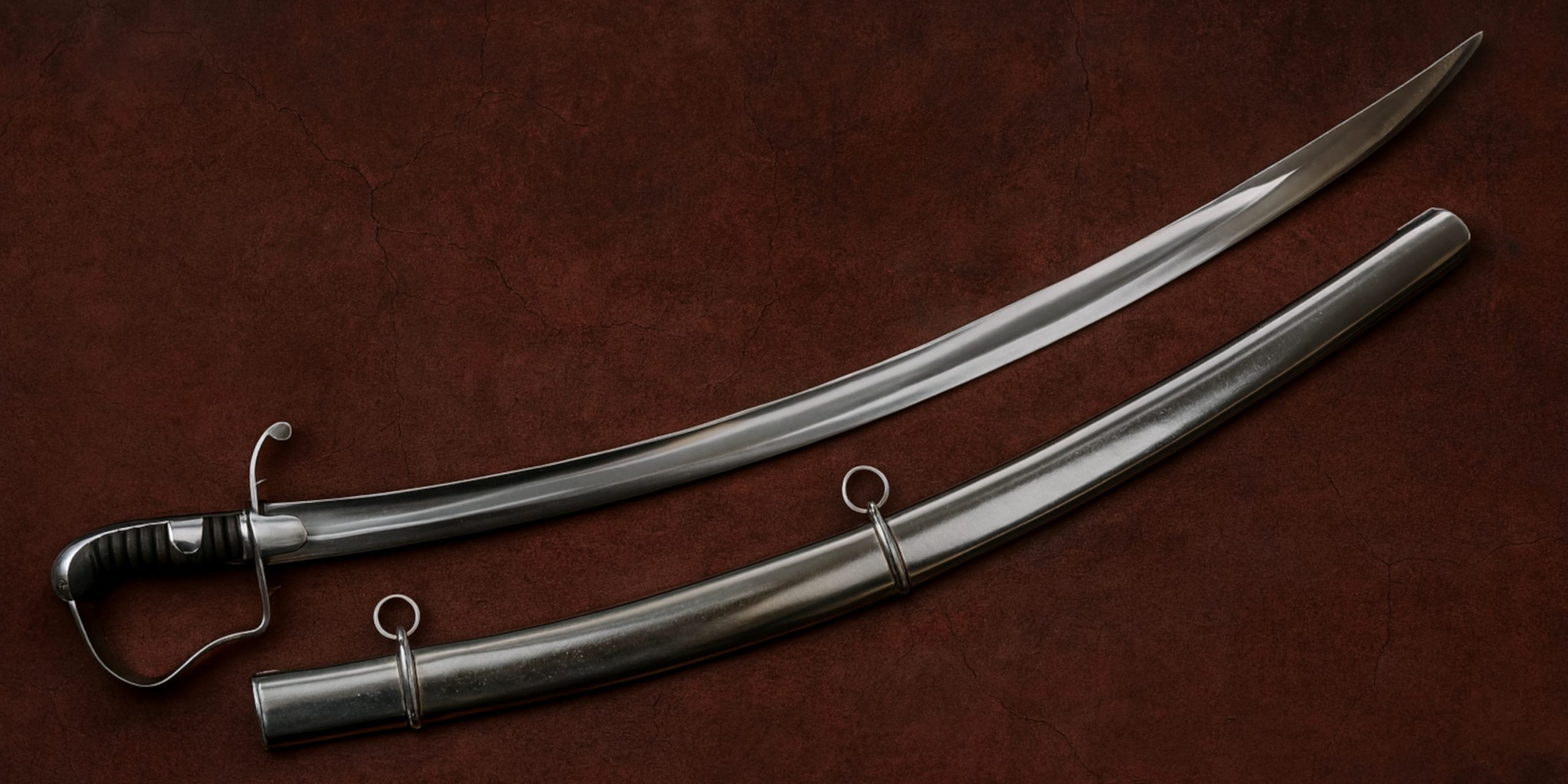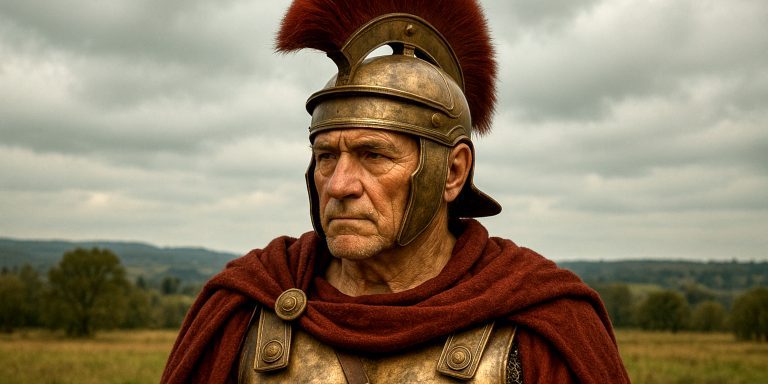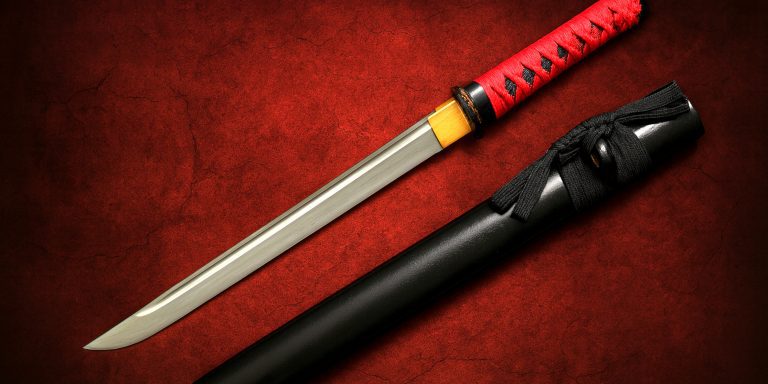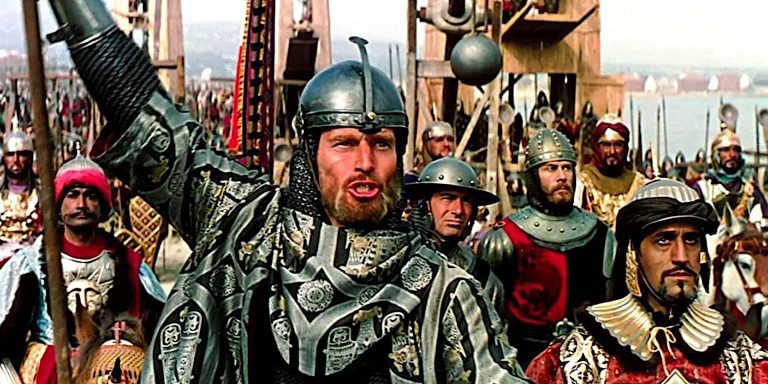
Few weapons evoke the Napoleonic Wars quite like the British Pattern 1796 Light Cavalry Sabre. Its curved blade, designed for slashing at speed from horseback, became an icon of British cavalry warfare. Issued to light cavalry units such as the 7th Hussars and 15th Light Dragoons, the sabre was famed for its brutal cutting power and distinctive profile. It drew both admiration and horror from those who faced it, and its silhouette still defines early nineteenth-century cavalry arms.
Specification
| Feature | Detail |
|---|---|
| Type | Light Cavalry Sabre |
| Origin | Britain |
| Introduced | 1796 |
| Designer | Henry Osborn (based on designs by John Gaspard Le Marchant) |
| Overall Length | Approx. 89–95 cm |
| Blade Length | Approx. 82–83 cm |
| Blade Type | Single-edged, curved, with hatchet point |
| Weight | Around 900–1000 g |
| Grip | Ribbed wood covered with leather and bound with wire |
| Guard | Simple stirrup-type guard of iron |
| Scabbard | Steel, often with twin suspension rings |
| Users | British Light Dragoons, Hussars, some foreign allies (Portuguese, Prussian, etc.) |
History and Evolution
The Pattern 1796 emerged from the reforming zeal of John Gaspard Le Marchant, a British officer frustrated by the poor quality of British cavalry swordsmanship and equipment. After observing Austrian sabres during campaigns in Europe, Le Marchant collaborated with Birmingham sword-maker Henry Osborn to design a weapon suited to the realities of cavalry combat.
The result was a blade optimised for cutting power. Unlike the earlier straight-bladed models, the 1796’s pronounced curve and hatchet point made it devastating in the downward slashing attacks used by light cavalry. It was officially adopted in 1796 and became the standard weapon for British light cavalry through the Napoleonic Wars and beyond.
After 1821, newer patterns with less curve and a spear point gradually replaced it, reflecting changing doctrines that favoured thrusting over cutting. Nonetheless, the 1796 pattern influenced sabre design across Europe, with variants appearing in Prussian, Portuguese, and Indian service.
Advantages and Disadvantages
Advantages
- Exceptional Cutting Power: The curve and weight distribution made it deadly in slashing attacks.
- Simplicity: A sturdy, functional guard and grip allowed for quick manufacture and easy maintenance.
- Battle-Proven: Highly effective in the chaos of cavalry charges where speed and ferocity mattered most.
- Iconic Design: Its shape became synonymous with British cavalry style and later inspired ceremonial patterns.
Disadvantages
- Limited Thrusting Ability: The hatchet point was poor for penetrating armour or thick clothing.
- Uneven Balance: Some soldiers found it heavy near the tip, reducing control in prolonged combat.
- Crude Finish (Common Versions): Many mass-produced examples were roughly made compared to officers’ models.
- Outdated by Mid-19th Century: Changes in cavalry tactics and the rise of firearms reduced its battlefield relevance.
Comparison with Similar Weapons
| Weapon | Nation | Blade Type | Strengths | Weaknesses |
|---|---|---|---|---|
| 1796 Light Cavalry Sabre | Britain | Curved, hatchet point | Excellent cutter, simple design | Weak thrust, tip-heavy |
| Prussian Model 1811 (Blücher Sabre) | Prussia | Slightly heavier, similar shape | Durable, good balance | Less elegant, heavier |
| French AN XI Light Cavalry Sabre | France | More uniform curve | Better control | Less powerful cut |
| British 1821 Light Cavalry Sabre | Britain | Reduced curve, spear point | Improved thrusting | Weaker slashing |
| Indian Tulwar | India | Deep curve, disc pommel | Superb slicing | Poor European-style balance |
The Prussian Model 1811 deserves special note. So similar was it to the British original that German soldiers dubbed it “the Blücher sabre,” in honour of the general who fought alongside Wellington.
Legacy
The 1796 sabre’s reputation outlived its service life. Veterans of Waterloo and the Peninsular War recalled its terrifying efficiency, and its curved form remains instantly recognisable. The sabre influenced weapon design across Europe and was used well into the colonial period.
Its presence in regimental museums, paintings, and reenactments cements it as one of the defining symbols of Britain’s Napoleonic military era. Even today, ceremonial sabres in British cavalry units trace their lineage to Le Marchant’s creation.
Contemporary accounts spoke of the carnage it caused. One French officer described the aftermath of a charge by British sabres as “a scene of butchery beyond comprehension”. Such remarks, though grim, testify to its effectiveness.
Where to See the Pattern 1796 Sabre
- National Army Museum, London – several examples from Waterloo and the Peninsular War.
- Royal Armouries, Leeds – includes both troopers’ and officers’ models.
- Museum of the King’s Royal Hussars, Winchester – fine displays with context on the 7th and 15th Hussars.
- Wellington Museum, Waterloo, Belgium – artefacts related to the 1815 campaign.
- Cavalry Museum, Sandhurst – contextual examples of cavalry weapons evolution.
Collectors Guide and Auction Prices
Collector Interest
- Highly sought by Napoleonic collectors and cavalry enthusiasts.
- Officers’ models (often etched and finely finished) command the highest values.
- Provenance (especially battlefield recovery or named pieces) greatly increases worth.
- Reproductions exist but are easily distinguished by modern materials and finish.
Recent Auction Prices
| Type | Condition | Sale Price (GBP) | Notes |
|---|---|---|---|
| Trooper’s Pattern 1796 | Good, complete | £700–£1,000 | Common, strong collector demand |
| Officers’ Pattern (Etched Blade) | Excellent | £1,500–£3,000 | High-quality decorative features |
| Named Waterloo Example | Museum grade | £5,000+ | Extremely rare, historical provenance |
| Replica / Reproduction | New | £150–£300 | Functional, used for reenactment |
Care and Preservation
- Avoid aggressive polishing; patina preserves authenticity.
- Oil the blade lightly to prevent rust.
- Handle the grip minimally to protect leather and wire bindings.
- Store horizontally in dry, stable humidity.
The Seven Swords Takeaway
The British Pattern 1796 Light Cavalry Sabre remains one of the most distinctive and effective weapons of its age. Forged from the insights of warfare and shaped by British innovation, it combined simplicity, elegance, and savage efficiency. More than two centuries later, its line and legend endure, a symbol of the speed and ferocity that once defined the light cavalry charge.



